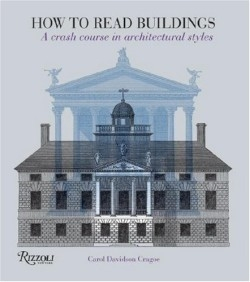How To Read Buildings
A Crash Course in Architectural Styles
“Understanding buildings is like detective work: you need to look for clues that will lead you to recognize the building,” the author writes. First, however, one needs a background in architectural styles or at least a compact reference guide.
How To Read Buildings begins with building types such as religious, castle, palace, domestic, public, and commercial. Cragoe, an architectural historian, writer, and lecturer who studied in New York and London, next examines particular period-based styles: Greek, Roman, Christian, Byzantine, Romanesque, Gothic, Renaissance, Baroque, Rococo, Palladian, Neoclassical, Gothic Revival, Late nineteenth-century, and Modernism of the twentieth century. Another section discusses structural materials including stones, brick, masonry, wood, iron, steel, concrete, glass, and roofing, such as steeply pitched with dormer windows. These are what the author identifies as the three key aspects of the “grammar of architectural language.”
Within this grammatical language is a vocabulary of building parts such as arches, vaults, roofs, towers, doors, and windows. In discussing columns and capitals, for example, orders are delineated: Doric characteristics are its frieze with alternating metopes and triglyphs; Ionic with characteristic scrolled capitals and fluted columns; and Corinthian with its capital covered with rows of acanthus leaves. Also, Christian capitals are discussed with references to the fold capital with its textile-like pattern of foliage intertwining in a guilloche pattern. Interesting are descriptions such as small, decorative points projecting from a curve of an arch known as cusping; the grotesque and “fanciful motifs of stylized animals and bird heads chomping down on rolled molding,” and sculpted keystones that decorate the center of a vault.
With the architectural background presented, one is able to recognize key characteristics. For example, in a comparison of The Temple of Hephaestus, built in Athens in 449 BC using the Doric Order and St. Pancras Church built in London in 1819-22 in Greek Revival style, the row of six columns topped by a triangular pediment on the front of the church looks like the front of the temple. Borrowing architectural cues from the Greek results in Greek Revival.
The draftsmanship of the fine pen and ink drawings, the color-coding of sections, the compactness of trim size, and the quantity of material presented, makes for an illuminated text. A book of architecturally refined elegance on a small scale.
Disclosure: This article is not an endorsement, but a review. The publisher of this book provided free copies of the book to have their book reviewed by a professional reviewer. No fee was paid by the publisher for this review. Foreword Reviews only recommends books that we love. Foreword Magazine, Inc. is disclosing this in accordance with the Federal Trade Commission’s 16 CFR, Part 255.

